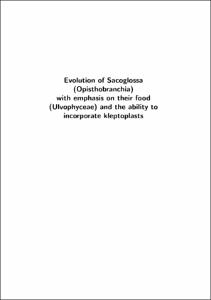Händeler, Katharina: Evolution of Sacoglossa (Opisthobranchia) with emphasis on their food (Ulvophyceae) and the ability to incorporate kleptoplasts. - Bonn, 2011. - Dissertation, Rheinische Friedrich-Wilhelms-Universität Bonn.
Online-Ausgabe in bonndoc: https://nbn-resolving.org/urn:nbn:de:hbz:5N-24585
Online-Ausgabe in bonndoc: https://nbn-resolving.org/urn:nbn:de:hbz:5N-24585
@phdthesis{handle:20.500.11811/4951,
urn: https://nbn-resolving.org/urn:nbn:de:hbz:5N-24585,
author = {{Katharina Händeler}},
title = {Evolution of Sacoglossa (Opisthobranchia) with emphasis on their food (Ulvophyceae) and the ability to incorporate kleptoplasts},
school = {Rheinische Friedrich-Wilhelms-Universität Bonn},
year = 2011,
month = mar,
note = {Sacoglossa (Gastropoda) feed mainly on siphonous or siphonocladous green algae and are well-known for their ability to incorporate kleptoplasts from their food algae (Ulvophyceae). Some sacoglossans are capable of a functional plastid retention for a specific time which varies interspecific. The aim of this study was to gain insight into the evolution of Sacoglossa under special consideration of their ability to incorporate kleptoplasts.
Photosynthesis was investigated by measuring the development of chlorophyll a fluorescence of starving animals during time with the help of a Pulse Amplitude Modulated Fluorometer (Diving-PAM) among all higher taxonomic groups of Sacoglossa. Three different classes of photosynthetic abilities were distinguished: a) no functional retention, b) functional retention for a short time and c) functional retention for a long time (several weeks up to months). A phylogenetic analysis based on three molecular markers (partial), i.e. 28S rDNA, 16S rDNA and coxI, was performed. A new barcode to determine food of sacoglossan slugs was established, i.e. the protein encoding chloroplast gene tufA.
No functional retention was found in the monophyletic Oxynoacea and most of the cerata-bearing Limapontioidea. Monophyly of Limapontioidea can neither be confirmed nor rejected due to missing resolution. Functional short term retention was found in the monophyletic parapodia-bearing Plakobranchoidea and the monogeneric Costasiellidae. However, specific quality of functional retention differs, since members of Costasiellidae show a cyclic activity, while chlorophyll fluorescence in plakobranchoidean slugs decreases with time linearly. Functional retention for several weeks up to months evolved independently in four plakobranchoidean sacoglossans. Data on food organisms of Sacoglossa from literature and data gained from barcoding via tufA revealed that neither short-term nor long-term retention are correlated to food algae.},
url = {https://hdl.handle.net/20.500.11811/4951}
}
urn: https://nbn-resolving.org/urn:nbn:de:hbz:5N-24585,
author = {{Katharina Händeler}},
title = {Evolution of Sacoglossa (Opisthobranchia) with emphasis on their food (Ulvophyceae) and the ability to incorporate kleptoplasts},
school = {Rheinische Friedrich-Wilhelms-Universität Bonn},
year = 2011,
month = mar,
note = {Sacoglossa (Gastropoda) feed mainly on siphonous or siphonocladous green algae and are well-known for their ability to incorporate kleptoplasts from their food algae (Ulvophyceae). Some sacoglossans are capable of a functional plastid retention for a specific time which varies interspecific. The aim of this study was to gain insight into the evolution of Sacoglossa under special consideration of their ability to incorporate kleptoplasts.
Photosynthesis was investigated by measuring the development of chlorophyll a fluorescence of starving animals during time with the help of a Pulse Amplitude Modulated Fluorometer (Diving-PAM) among all higher taxonomic groups of Sacoglossa. Three different classes of photosynthetic abilities were distinguished: a) no functional retention, b) functional retention for a short time and c) functional retention for a long time (several weeks up to months). A phylogenetic analysis based on three molecular markers (partial), i.e. 28S rDNA, 16S rDNA and coxI, was performed. A new barcode to determine food of sacoglossan slugs was established, i.e. the protein encoding chloroplast gene tufA.
No functional retention was found in the monophyletic Oxynoacea and most of the cerata-bearing Limapontioidea. Monophyly of Limapontioidea can neither be confirmed nor rejected due to missing resolution. Functional short term retention was found in the monophyletic parapodia-bearing Plakobranchoidea and the monogeneric Costasiellidae. However, specific quality of functional retention differs, since members of Costasiellidae show a cyclic activity, while chlorophyll fluorescence in plakobranchoidean slugs decreases with time linearly. Functional retention for several weeks up to months evolved independently in four plakobranchoidean sacoglossans. Data on food organisms of Sacoglossa from literature and data gained from barcoding via tufA revealed that neither short-term nor long-term retention are correlated to food algae.},
url = {https://hdl.handle.net/20.500.11811/4951}
}






